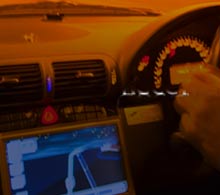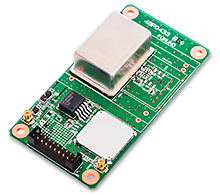Articles for ITS market Rapid development of sharing economy
Three "V" and MaaS (Mobility as a Service) in the second New Mobility World
The New Mobility World Show, which is being held jointly at the IAA (International Auto Show: Frankfurt Motor Show) in Frankfurt, Germany, was a great success. New Mobility World is an event to introduce the fact that industry, academia and government are talking about the next generation of transportation and automobile industry to the people in the automobile industry who visit the show. The first meeting, held at the Frankfurt Motor Show two years ago, did not meet the expectations of the organizer because the number of visitors was quite small. However this year was a great success as there was much higher attendance and the flow of people was strong during all the days of the Show. Those changes reflect the influence of time and the change that the automotive industry is now facing.
In the IAA, so-called German three (Daimler, BMW and VW) announced their Production Model and Concept Model about the Electric Vehicles (EV), Automated Vehicles (AV) and Connected Vehicle (CV). These three "V’s" are trends in the worldwide automobile industry and major automobile manufacturers such as Bosch, Continental, and Delphi are rushing to develop products. There is also the service area that closely cooperates with the three "V" and it is called “MaaS” (Mobility as a Service). Under such circumstances, major IT, electronics, and communications companies also expanded the business related to the three "V" and at the second New Mobility World. An example is that the major semiconductor company QUALCOMM, had their CEO, Steve Mohrenkov, presenting the opening keynote lecture.
From the ride sharing (Passenger) to the commercial sharing (Logistics)
The concept of MaaS covers a very wide business area, but the most of the attention was given to sharing.
The sharing business has rapidly increased in recent years such as “Air B&B’s” which rent private owned houses to the travelers and the “Ride sharing” which uses private owned vehicles as taxis like the Uber and the Lyft in the Western countries, China and Southeast Asia. In the second New Mobility World, lots of ride sharing companies launched their own booths like the European and the US ride sharing companies as well as the Chinese bicycle sharing company which has been rapidly growing since last year in China.
Under such circumstances, “Commercial sharing" is expected to be the future trend.
"Commercial sharing" here means “Logistics sharing”, not “Passenger ride sharing”.
As an example of a demonstration experiment that has been carried out up to now in the commercial sharing, Audi cooperates with DHL, a major logistics company, and doing the demonstration. Specifically said, they try to use an individual owned car for the delivery and testing a system that can lock and unlock the trunk of an individual owned car by an electronic key.
However, the commercial sharing is unlike C to C (customer-to-customer) business such as private houses and ride sharing. It is basically built in B to B (between operators) business model. In the C to C, the commercialization could be completed quickly because it is mainly up to the development of smartphone applications. However, the B to B model needs long term efforts because of the balance and negotiation between existing operators or administrative organs is required.
What will the Logistics Sharing be like in the future?
There are two cities which have had good case studies on promoting advanced plans for the Logistics Sharing, one is Singapore, and another is Boston, Massachusetts.
At the second New Mobility World, officials from the Singapore Ministry of Transportation and an officer of the World Economic Forum who is an Advisory on Boston City's transport policy, provided lectures and explained the Logistics Sharing in the future.
What I was interested in the most was the plan of Singapore. It makes all the traffic in the city built underground. Commercial buses and taxis will be arranged on the first basement floor and passenger cars will be restricted from that level. The second basement floor will be used for logistic distributions, for example, an exclusive transportation to the back of large shopping malls. Furthermore, several stores in the malls will share the services of logistics service. Singapore is a small country, the total area is less than Berlin in Germany, but five million people live there and numerous types of companies are doing their business there. Therefore the traffic is always an important issue. In response to such circumstances, the Singaporean Government will proactively utilize the latest technologies of EV, AV and CV, and promote the practical application of MaaS including new logistics service.
I am expecting that many cases of MaaS involving Cars, IT, Communications and Logistics industries will be developed in Japan as well.
Writer introduction

Mr. Kenji Momota Automotive journalist
His major is the world automotive industry and he is also familiar with the energy industry, IT and the aging society problem as the related fields. He acts around the world based in Japan and USA and writes for the general magazines, the technology journals and the automotive related media etc.
He is also commentator of motor race and world's motor show on TV program based on his career of the driver of Indy Racing League and NASCAR. In recent years, he has been covering about a paradigm shift from developed countries to developing countries, the motorized vehicle like EV and the telematics.
FURUNO ITS Journal
Click here for the latest articles after 2022 (in Japanese)2022
- The "realistic" self-driving roadmap shown by the Japanese government and a hands-on report on the latest Subaru EyeSight X
- Will FCVs (Fuel Cell Vehicles) Become Popular? ~New Movement in Toyota and Honda~
- The 'Complete' online sales of new cars start in Japan. Will this new way of buying cars take root?
- Many Firsts! On-Site Report from Tokyo Auto Salon 2022 - The author, who knows what goes on behind the scenes, looks back on 40 years of history. -
2021
- "Moving toward zero traffic fatalities for four-wheeled and two-wheeled vehicles globally in 2050" ~Experience on Honda's latest safety technologies~
- Tsuneishi Shipbuilding's building and DX, an exclusive visit to the main factory
- Japan's Smart City: New Moves toward Practical Use
- When will self-driving buses (service cars) be put to "full-scale" practical use?
- Utilization vehicle data during disasters
- Toyota-led Connected Technology to Transform Commercial Vehicle Business -From light trucks to large trucks and buses-
- Toyota enters the connected car "Personalization" business
- Japanese automakers' carbon-neutral strategies swept up in ESG investment
- Drive experience of the latest autonomous vehicle models and advanced driving support systems
- Will carbon neutrality accelerate the trend to strengthen LCA (Life Cycle Assessment)?
- Semiconductor shortage exposes realities of the automotive industry
- Online Autonomous Driving Contest Enhancing development of Human Resources
2020
- What happens to CASE when gas cars are banned in Japan?
- When will Flying Cars be launched?
- Expectation vs. reality:Autonomous Driving in Japan
- V2X, Becoming increasingly important in autonomous driving
- Technology of Subaru “EyeSight X”
- Lifestyle-oriented French cars gain popularity in Japan
- Human-oriented smart cities are wanted
- MaaS and CASE, how would automotive industry change after COVID-19?
- The beginning of virtualization era, triggered by COVID-19
- Trend of EV shift and consumer demands
- TOYOTA Press conference about ADAS - Releasing algorithm for "sudden acceleration suppression during attempted sudden acceleration" free of charge -
- The Japanese automotive industry in 2020 - 3 turning points -
- "Using a smartphone while driving" and "Level 3 automated driving"
2019
- Motor show business model is at a turning point - Tokyo Motor Show Report -
- Commercialization and monetization of MaaS - ITS World Congress Singapore Report -
- Android Automotive pays attention to V2X - Report from the Frankfurt Motor Show 2019 in Germany -
- Automobile Distribution Revolution and DCM (Data Communication Module)
- Connected business potential and newly proposed "eMaaS" by Honda
- 5G services for practical use are multiplying
- Connectivity technologies attracting attention due to frequent traffic accidents
- Shanghai Motor Show report -SUV, EV, Automated car & 5G-
- Drone Business roadmap and updates to Michibiki (Quasi-Zenith Satellite System)
- MaaS (Mobility as a Service) "town development." Full-scale promotion for a national project
- CES organizer states "Data Period in 2020s." Transformation of the Automotive Industry in CES, US "-CES2019 Report-"
- "Return to Origin" directed towards the age of change, automatic operation and connectivity
2018
- New proposal for Private Car Automated Driving Level and other Hot 5G Technology Topics
- Standardized EV charging infrastructure concerns in Europe, US, Japan and China - Kobe EVS 31 field report -
- Touring a pure car carrier and a test drive of the latest hybrid car
- Planning stage products are exhibited at the newly established visualized mobility service "TOYOTA MOBILITY SHOWROOM".
- Potential “Community Car-share” program promoted by local residents
- CES Asia Report 2108
- Companies attempt new Vehicle-to-Infrastructure communications, including traffic volume measurements and vehicle positioning. -ITS Asia Pacific Forum in Fukuoka-
- Geneva show in Switzerland. Flying cars and MaaS (Mobility as a Service) were hot topics.
- EV (Electric Vehicle) proposals by country
- MaaS competition through service mobilization, M & A and technical field collaboration is accelerating. - The CES 2018 Report -
2017
- Big data’s initiative and fight for the automotive industry. Cooperation among companies becomes increasingly important.
- Connected car and road-to-vehicle communication automatic operation
- ETC (Electronic Toll Collection) and ETC2.0. Current situation and projected future
- Rapid development of sharing economy
- Germany is first to recognize level 3 automated driving
- ITS EU 2017 Field Reports -Automatic Operation and the eCall-
- From Infotainment to ITS, the competitive area is spreading in the car big data industry.
- GTC (GPU Technology Conference) Report and the de facto standardization of AI (artificial intelligence)
- Renesas' new challenge! "e-AI Solution" and "Renesas Autonomy"
- The Automobile industry is shifting from a manufacturing industry to a service industry.
- The movement toward accident countermeasures for aging drivers in Japan
- Fusion of ride sharing and fully automated driving is advancing in the USA.
2016
- Overview of the Quasi-Zenith Satellite System (QZSS) and advancements toward full-scale practical use including the Tokyo Olympic Games - G-space EXPO 2016 report-
- Japan’s automated driving project "SIP-adus" will be a large demonstration experiment.
- The International Home Care & Rehabilitation Exhibition. There were many car manufactures with exhibits booths at this show.
- Japanese car manufacturers starting to concentrate on strengthening the ADAS system
- A new movement of legislation for autonomous cars
- Cyber Security and “AGL”, the new OS for automotive are hot topics in the connected car industry
- “High precision 3D map” the key future of autonomous car and pedestrian dead reckoning
- Chinese “BAT” is accelerating their business in the EV (Electric Vehicle) market
- Tesla's original connection to Taiwan and the new transportation system technologies.
- "The main topic" of the Geneva Motor Show was how to strengthen "pedestrian protection"
- The probe data business is getting more competitive
- Reporting directly from the 2016 CES show "Data services will soon become the main revenue source of automotive industry"
2015
- Do the automated driving systems need the GNSS (Global Navigation Satellite System) ?
- ETC Version 2.0 is coming soon. A new service was announced at the Tokyo Motor Show and the possibility that is could be used as a device for older drivers.
- "Connected Horizon" and "eHorizon". Germany's leading parts supplier accelerates strengthening of "Big Data" for business



 The 2nd New Mobility World was a great success.
The 2nd New Mobility World was a great success.  The integration of EV, AV, CV and MaaS advances cooperation between the automobile industry and the communication industry. Samsung Electronics in Korea acquired Harman, a major automotive component company in March 2017. The newly acquired Harman had an exhibition booth at the show.
The integration of EV, AV, CV and MaaS advances cooperation between the automobile industry and the communication industry. Samsung Electronics in Korea acquired Harman, a major automotive component company in March 2017. The newly acquired Harman had an exhibition booth at the show. Keynote lecture by Steve Mohrenkov, a CEO of QUALCOMM at New Mobility World.
Keynote lecture by Steve Mohrenkov, a CEO of QUALCOMM at New Mobility World. A state of urban transport in the future introduced by the Singaporean government lecture. Buses and commercial vehicles run underground.
A state of urban transport in the future introduced by the Singaporean government lecture. Buses and commercial vehicles run underground. An illustration of a demonstration test on traffic related in Boston City, introduced in the announcement by the World Economic Forum.
An illustration of a demonstration test on traffic related in Boston City, introduced in the announcement by the World Economic Forum. GPS/GNSS Receiver&Chips and Modules (positioning and timing)
GPS/GNSS Receiver&Chips and Modules (positioning and timing)